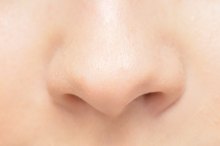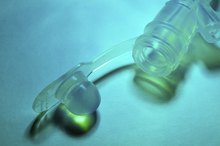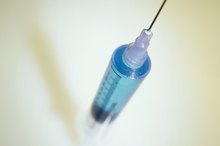What Are the Side Effects of Feeding Tubes?
A feeding tube is a long, narrow tube inserted into the stomach indirectly through the nose or mouth, or directly through the abdomen. During feeding, liquid food products pass into the stomach through the feeding tube, ensuring that patients receive adequate dietary nutrition and caloric intake. Each year, doctors place over 200,000 feeding tubes in patients, according to the Oral Cancer Foundation. Patients should discuss the potential side effects of feeding tubes with a medical professional before having a feeding tube placed.
Aspiration
One of the most common side effects of feeding tubes is aspiration, notes the Oral Cancer Foundation. Aspiration occurs when a patient inhales liquid food into the lungs as it passes along the feeding tube. Side effects of aspiration can include difficulty breathing, cough or recurrent lung infections such as pneumonia. To limit the development of such side effects, patients with feeding tubes should only be fed while sitting upright.
- One of the most common side effects of feeding tubes is aspiration, notes the Oral Cancer Foundation.
Irritation
Complications of Hiatal Hernia Surgery
Learn More
Patients who receive a feeding tube can experience tissue irritation at the site of insertion, such as the nose, mouth or abdominal wall, the University of California Davis Medical Center reports. Irritation can result in sensations of pain or discomfort along the digestive tract and may contribute to upset stomach side effects in certain people. Stomach irritation can cause symptoms of diarrhea, nausea, vomiting or abdominal bloating.
Organ Puncture
Infrequently, a feeding tube may puncture an organ along the digestive tract, such as the stomach. Organ puncture increases a patient's risk of leaking blood or ingested food products into the abdominal cavity. If this occurs, patients can develop a severe abdominal infection called peritonitis, the University of Pennsylvania Health System warns. Side effects of peritonitis can be life-threatening, and include:
- fever
- abdominal swelling
- pain
- nausea
- vomiting or diminished appetite
- Infrequently, a feeding tube may puncture an organ along the digestive tract, such as the stomach.
Misplacement or Migration
How to Detect a Feeding Tube Infection
Learn More
Feeding tube misplacement or migration can arise as a side effect. Tube misplacement can result in heart rate or breathing abnormalities, especially in infants, according to MedlinePlus 2. If a feeding tube migrates out of its appropriate position, a patient may need to undergo additional surgery to have the feeding tube replaced in its proper spot. Feeding tube misplacement or migration also increases a patient's risk of experiencing tissue irritation along the length of the tube.
- Feeding tube misplacement or migration can arise as a side effect.
- Feeding tube misplacement or migration also increases a patient's risk of experiencing tissue irritation along the length of the tube.
Infection
Feeding tubes can elevate a patient's risk of infection, the UCD Medical Center reports. Infection symptoms include fever, chills, pain and fatigue. Affected patients typically require additional antibiotic treatment to resolve infection side effects resulting from feeding tubes.
Related Articles
References
- University of Pnnsylvania Health System: Consent for Percutaneous Feeding Tube Placement
- MedlinePlus: Feeding Tube - Infants
- Wilmskoetter J, Simpson KN, Bonilha HS. Hospital Readmissions of Stroke Patients with Percutaneous Endoscopic Gastrostomy Feeding Tubes. J Stroke Cerebrovasc Dis. 2016;25(10):2535-42.
Writer Bio
Rae Uddin has worked as a freelance writer and editor since 2004. She specializes in scientific journalism and medical and technical writing. Her work has appeared in various online publications. Uddin earned her Master of Science in integrated biomedical sciences with an emphasis in molecular and cellular biochemistry from the University of Kentucky College of Medicine.









